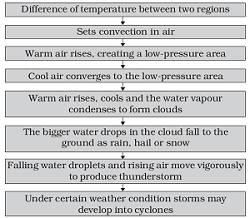Winds Storms and Cyclones - Revision Notes
CBSE Class 7 Science
Revision Notes
Chapter – 8
Winds Storms and Cyclones
- Air: The invisible gaseous substance surrounding the earth.
- Composition of air: By volume, dry air contains 78.09% nitrogen, 20.95% oxygen, 0.93% argon, 0.04% carbon dioxide, and small amounts of other gases. Air also contains a variable amount of water vapour, on average around 1% at sea level, and 0.4% over the entire atmosphere.
- Properties of Air:
(i) Air around us exerts pressure.
(ii) Air expands on heating and contracts on cooling.
(iii) Warm air rises up, whereas comparatively cooler air tends to sink towards the earth’s surface.
(iv) As warm air rises, air pressure at that place is reduced and the cooler air moves to that place.
- Wind: The moving air is called wind. Air moves from region of high air pressure to region of low air pressure.
- Types of Wind:
(i) Wind Currents: Wind currents are generated due to uneven heating on earth.
(ii)Thunderstorms: Storm with thunder and lightning along with rain.
- Winds carrying water vapour bring rain.
- High-speed winds and air pressure difference can cause cyclones.
- It has become easier to monitor cyclones with the help of advance technology like satellites and radars.
- Self-help is the best help. Therefore it is better to plan in advance and be ready with defence against any approaching cyclone.
- The following flow chart will help you to understand the phenomena that lead to the formation of clouds and falling of rain and creation of storms and cyclones.

